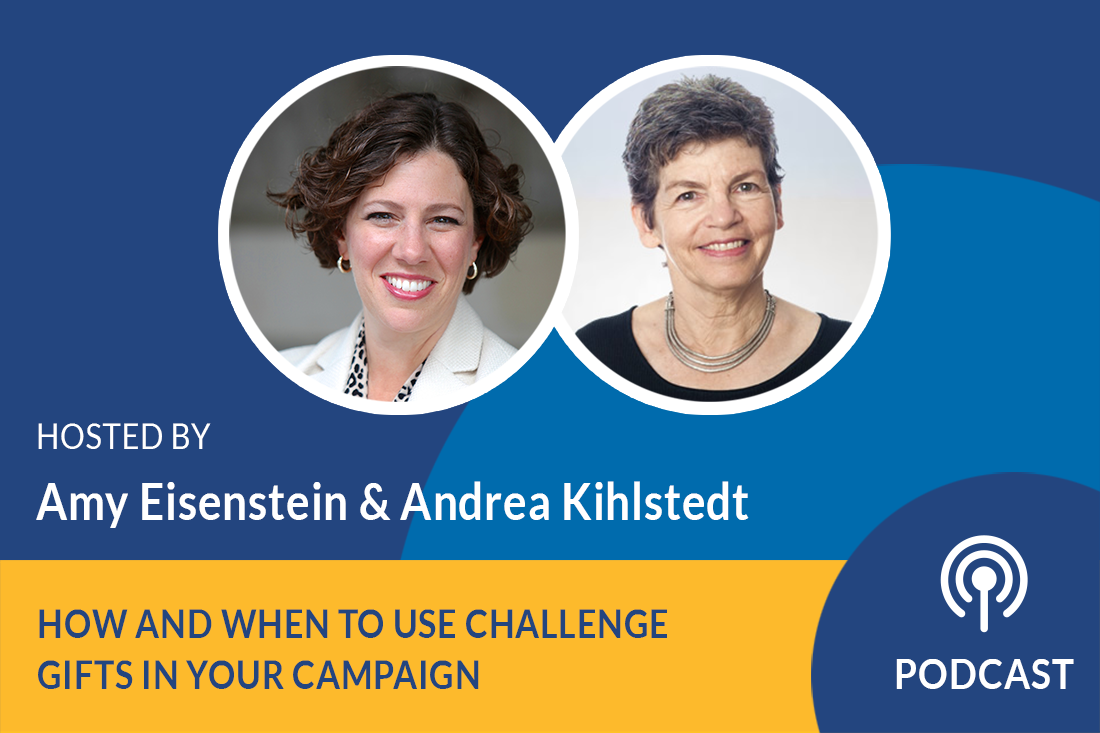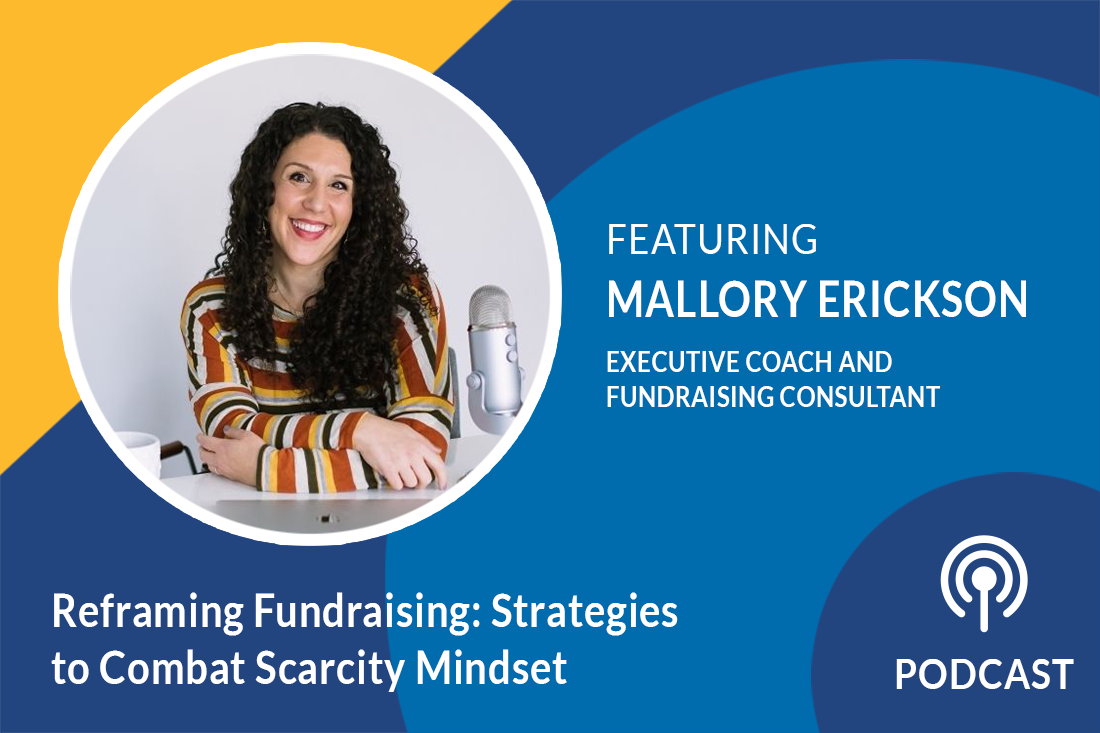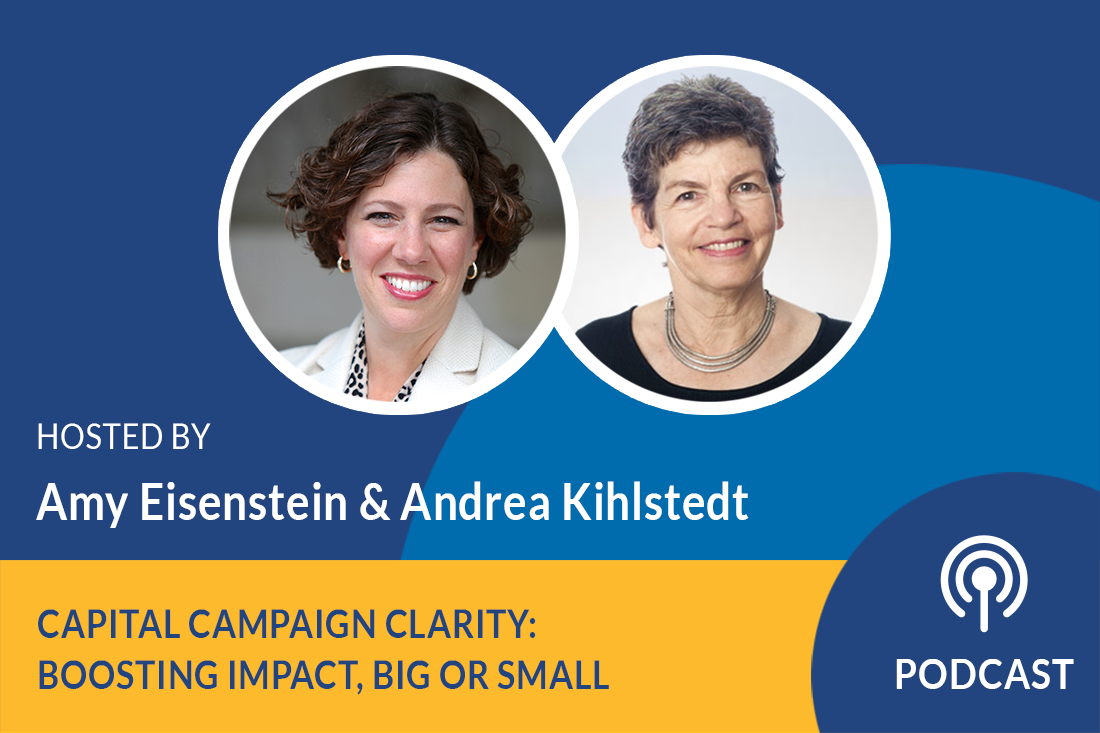Podcast: How and When to Use Challenge Gifts in Your Campaign

Season 3, Episode 18
Challenge Gifts are a wonderful way to generate excitement and buzz and create internal deadlines for your campaign. Join Amy Eisenstein and Andrea Kihlstedt as they discuss the best times and opportunities to use challenge gifts during a campaign.
Listen Now:
Amy Eisenstein:
Do you like a challenge? If so, you are not alone. Donors to capital campaigns love to leverage their gifts.
Hi, I’m Amy Eisenstein. I’m of course here with my colleague and co-founder, Andrea Kihlstedt, and we are excited to talk to you about challenge gifts in a capital campaign. When to use them, how they work, why they work. Andrea, kick us off and get us started on challenge gifts during a campaign.
Andrea Kihlstedt:
Thanks, Amy. These are so important.
Capital campaigns are long — many campaigns last three years, and while there are certain markers for phases of a campaign, there’s a very long phase in the middle, this quiet phase of a campaign, which can go on for a very long time without any deadlines, without any internal deadlines. You might be going for 12 months or 15 months or even 24 months. And without anything special to get everybody’s energy going, it feels like a long lull time. Capital campaign challenges are one way to address that and you can get people to create challenges in all sorts of ways.
First of all, the amazing thing about challenges is that some donors like to be challengers. And if you start to look at donor patterns, you’ll see that people will create a challenge here and they’ll create a challenge there, you can actually identify a lead donor to your campaign whom you suspect would rise to that opportunity. You could say:
“Joe, I see that in other campaigns you’ve created challenges. Would you like to give your large gift here as challenge to our community?”
And you can help that person craft a campaign challenge that is going to work for you and that he or she is going to feel good about.
Use Challenge Gifts to Motivate Donors
The first thing to think about is use a challenge to motivate the challenging donor.
Amy Eisenstein:
Right. The lead donor to leverage their gift and others by issuing the challenge. I don’t know if you’re going to get to this later, but you pointed to during the quiet phase. And of course, I think lots of people think about challenges as being more broad based. Challenging to get 100 donors in the next 30 days, or as many new donors as we can get in the next 30 days.
But early on or in the middle of the quiet phase, you might ask for a challenge to help leverage the next three major gifts to really motivate the next three biggest donors. You can use them in all different ways. You can create any rules you want around them.
Andrea Kihlstedt:
Let’s talk about that some.
You can, for example, get someone on your board to create a challenge for other board giving. You can get a board member to create a challenge for former board members, but that would be one way to do it. You can get someone to create a challenge for gifts of a certain size. Say:
“I will match gifts of $25,000 or more that come in between now and such and such a date.”
Amy Eisenstein:
Yeah, that’s what I was thinking of when I meant the next three donors. The next three donors of $100,000, we’ll match, or the next 10 donors of $50,000 or something. It can be time delineated, it can be money delineated, it can have whatever parameters you and that challenge donor decide that will be helpful to your campaign, motivating to other donors, and generate excitement.
But we always want a deadline, because this is to create internal pressure, internal and external pressure to provide a boost to the campaign, so it doesn’t go on forever.
Andrea Kihlstedt:
I have one great story with organization I’ve been part of for quite some time. When one of the founding board members decided it was time for him to step off the board, he had really done his work and he decided that other people should take over the leadership. When he left, he said:
“I’m going to give $50,000 to this organization if you can get five other people to give $50,000 by such and such a date.”
Now, for that organization, $50,000 was a huge gift. This was a small organization. But somehow his saying that he was going to do that if they could get five others motivated them to do that. And in one stroke, he actually boosted that organization’s fundraising to levels that had never imagined. I thought that was brilliant.
Amy Eisenstein:
Yeah, its. It is to get people to think outside the box and the good news, and one of the reasons that these things work is because donors like to have their money matched. They like to think of that they’re getting the organization twice as much as what they would be able to give alone, but it also gets them to think about bigger gifts. It can be.
Use Challenge Gifts at the End of a Campaign
Andrea Kihlstedt:
You can also use challenge gifts at the end of a campaign.
Let’s imagine a campaign that’s raised the bulk of its money, but it still has $500,000 left to go to get to the goal. Maybe they’ve raised 9.5 million and they’ve got 500,000 to get to 10 million, which might be their goal. Instead of just saying, “Alright, we’re going to go out and ask for lots and lots of little gifts,” they can go back to a donor and say:
“Would you give a challenge gift of $100,000 if we can raise the rest of the money by a certain date?”
Boy, that breathes some air and energy into the final piece of your campaign and into somebody who may have given an early large gift and already paid off their pledge, and they may be willing to come in as a challenger at the very end to help finish out the campaign.
They’re incredibly powerful, both to motivate lead donors and to have those challenge gifts motivate people to make the challenge in a timely way.
Amy Eisenstein:
We all love a deadline. Everybody waits until the last minute. And so, by creating this arbitrary deadline, which most deadlines are, but if you don’t have a deadline, then there’s less motivation and there’s less urgency and people sit back and relax. But by creating this deadline, there’s a sense that people need to finish quickly and everybody works towards it together, which is a nice rallying cry, either in the middle or at the end of a campaign.
3 Things to Consider for Challenge Gifts
Andrea Kihlstedt:
There are three things to think about when you think about challenge gifts.
- First is who were you going to go to issue the challenge, to be the challenger? And you will think about the people who are your major donors and who would be interested in rising to that. That’s number one.
- Number two is, what are the terms of the challenge? What would strategically help you? Is it your board fundraising that you’re trying to finish out? Is it the whole end of your campaign that you’re trying to finish out? Is it perhaps mid-level gifts? Is it trying to establish a deadline? Strategically, what are you trying to accomplish and how can you use the challenge to clarify those strategic objectives?
- And finally, who are you going to be challenging? Who are going to be the people who are going to actually match the challenge? And by when does the challenge need to take place? What’s the deadline and how are you going to go about soliciting gifts for that deadline?
We have three things that you need to be thinking about, and you can do this not once, not twice, but three times and more in the context of a [capital] campaign. Campaign might have several challenges going to different people to be the challengers and different constituents to be the donors.
Amy Eisenstein:
Right. I think that’s such an important point because if an organization thinks about issuing three challenges, you may not be going to your whole community. You may first be doing a challenge for the board and only the board members know about that challenge, so you’re not issuing the same challenge over and over, and people are like, “Oh, that organization’s always trying to match my money.”
The second challenge may only be told to people who have the capacity to give 25,000 or more in one-on-one conversations saying, “We have one donor who’s issued a challenge. We’re trying to get 10 people and we’re talking to you as one of the 10.” Again, you’re not advertising it to your whole list or the whole community.
And then the third time, maybe at the end of the campaign, you are going to the whole community to leverage a challenge gift, but having different rules and different objectives and different criteria does make it really workable and not redundant.
Don’t Be Afraid to Negotiate Terms with Donors
Andrea Kihlstedt:
Amy, I’ve been working on a campaign where they had a fairly complicated challenge. One of their lead donors said:
“We are tired of being the only lead donor game in town. We want to create a challenge that’s going to get new donors in. So, our challenge is we’re going to put up a certain amount of money, but you have to bring donors in who have not been donors to your organization before in order to match that challenge.”
Well, that’s tough.
Amy Eisenstein:
That’s tough. Those are the hardest for sure.
Andrea Kihlstedt:
Those are the hardest. The organization went back to them and said:
“We are worried that about whether we’re going to be able to do that, particularly in the context of a capital campaign.”
Mostly, that’s not the time to be bringing in new donors to this campaign.
“What if instead of having a one-to-one match, you give $2 for every dollar we bring in and new money?”
They negotiated what the match would be because they were afraid of the challenge. The point there was that the actual terms of the challenge could, can be negotiated with the donor. You don’t want to take on a challenge you’re not going to be able to succeed at, but you can certainly talk to the donor and say:
“Here’s what we think we can do. Why don’t we structure it that way?” And that that’s what happened, actually, with this organization. They were successful.
Amy Eisenstein:
I love it. Be creative in your challenges. Be intentional and purposeful and use them to leverage new and old donors throughout your campaign. Andrea, I think that is brilliant advice and great food for thought for our listeners, so thank you always for leading that thoughtful conversation.
Andrea Kihlstedt:
Happy challenges, Amy.
Amy Eisenstein:
Happy challenges.



Leave a Comment